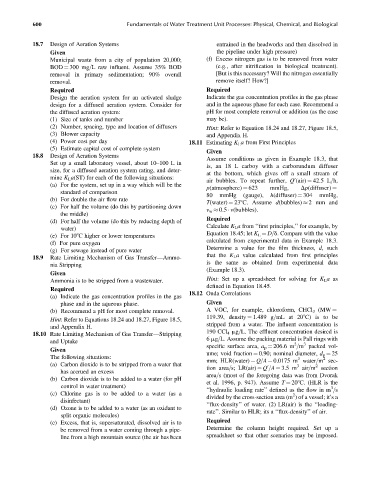Page 645 - Fundamentals of Water Treatment Unit Processes : Physical, Chemical, and Biological
P. 645
600 Fundamentals of Water Treatment Unit Processes: Physical, Chemical, and Biological
18.7 Design of Aeration Systems entrained in the headworks and then dissolved in
Given the pipeline under high pressure)
Municipal waste from a city of population 20,000; (f) Excess nitrogen gas is to be removed from water
BOD ¼ 300 mg=L raw influent. Assume 35% BOD (e.g., after nitrification in biological treatment).
removal in primary sedimentation; 90% overall [But is this necessary? Will the nitrogen essentially
removal. remove itself? How?]
Required Required
Design the aeration system for an activated sludge Indicate the gas concentration profiles in the gas phase
design for a diffused aeration system. Consider for and in the aqueous phase for each case. Recommend a
the diffused aeration system: pH for most complete removal or addition (as the case
(1) Size of tanks and number may be).
(2) Number, spacing, type and location of diffusers Hint: Refer to Equation 18.24 and 18.27, Figure 18.5,
(3) Blower capacity and Appendix H.
(4) Power cost per day 18.11 Estimating K L a from First Principles
(5) Estimate capital cost of complete system
Given
18.8 Design of Aeration Systems
Assume conditions as given in Example 18.3, that
Set up a small laboratory vessel, about 10–100 L in
is, an 18 L carboy with a carborundum diffuser
size, for a diffused aeration system rating, and deter-
at the bottom, which gives off a small stream of
mine K L a(ST) for each of the following situations:
air bubbles. To repeat further, Q (air) ¼ 42.5 L=h,
0
(a) For the system, set up in a way which will be the
p(atmosphere) ¼ 623 mmHg, Dp(diffuser) ¼
standard of comparison
80 mmHg (gauge), h(diffuser) ¼ 304 mmHg,
(b) For double the air flow rate
T(water) ¼ 238C. Assume d(bubbles) 2mmand
(c) For half the volume (do this by partitioning down
v w 0.5 v(bubbles).
the middle)
Required
(d) For half the volume (do this by reducing depth of
Calculate K L a from ‘‘first principles,’’ for example, by
water)
Equation 18.45; let K L ¼ D=d. Compare with the value
(e) For 108C higher or lower temperatures
calculated from experimental data in Example 18.3.
(f) For pure oxygen
Determine a value for the film thickness, d, such
(g) For sewage instead of pure water
that the K L a value calculated from first principles
18.9 Rate Limiting Mechanism of Gas Transfer—Ammo-
is the same as obtained from experimental data
nia Stripping
(Example 18.3).
Given
Ammonia is to be stripped from a wastewater. Hint: Set up a spreadsheet for solving for K L a as
defined in Equation 18.45.
Required
18.12 Onda Correlations
(a) Indicate the gas concentration profiles in the gas
phase and in the aqueous phase. Given
(b) Recommend a pH for most complete removal. A VOC, for example, chloroform, CHCl 3 (MW ¼
119.39, density ¼ 1.489 g=mL at 208C) is to be
Hint: Refer to Equations 18.24 and 18.27, Figure 18.5,
stripped from a water. The influent concentration is
and Appendix H.
190 CCl 4 mg=L. The effluent concentration desired is
18.10 Rate Limiting Mechanism of Gas Transfer—Stripping
6 mg=L. Assume the packing material is Pall rings with
and Uptake 2 3
specific surface area, a p ¼ 206.6 m =m packed vol-
Given
ume; void fraction ¼ 0.90; nominal diameter, d p ¼ 25
The following situations: 3 2
mm; HLR(water) ¼ Q=A ¼ 0.0175 m water=m sec-
(a) Carbon dioxide is to be stripped from a water that 3 2
tion area=s; LR(air) ¼ Q =A ¼ 3.5 m air=m section
0
has accrued an excess
area=s (most of the foregoing data was from Dvorak
(b) Carbon dioxide is to be added to a water (for pH
et al. 1996, p. 947). Assume T ¼ 208C. (HLR is the
control in water treatment) 3
‘‘hydraulic loading rate’’ defined as the flow in m =s
(c) Chlorine gas is to be added to a water (as a 2
divided by the cross-section area (m ) of a vessel; it’sa
disinfectant)
‘‘flux-density’’ of water. (2) LR(air) is the ‘‘loading-
(d) Ozone is to be added to a water (as an oxidant to
rate’’. Similar to HLR; its a ‘‘flux-density’’ of air.
split organic molecules)
(e) Excess, that is, supersaturated, dissolved air is to Required
be removed from a water coming through a pipe- Determine the column height required. Set up a
line from a high mountain source (the air has been spreadsheet so that other scenarios may be imposed.

